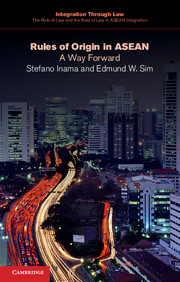Book contents
- Frontmatter
- Contents
- List of Tables
- General Editors’ preface
- Preface
- List of Abbreviations
- Chapter 1 Introduction
- Chapter 2 The initial set of ASEAN rules of origin: the lack of clarity and transparency masquerading as simplicity 1992–1995
- Chapter 3 Externalizing the confusion: the proliferation of rules in the ASEAN FTAs with dialogue partners
- Chapter 4 The silent cost: the cumbersome administration of ASEAN rules of origin
- Chapter 5 The possible way forward: self-certification
- Chapter 6 Conclusion and recommendations
- Executive Summary
- Appendices
- Appendix 1 1992 Agreement on the Common Effective Preferential Tariff Scheme for the ASEAN Free Trade Area
- Appendix 2 Rules of Origin for the CEPT
- Appendix 3 2009 ASEAN Trade in Goods Agreement
- Appendix 4 ATIGA Annex 3, Attachment 1 Substantial Transformation Criterion for Textiles and Textile Products
- Appendix 5 ATIGA Annex 5 Principles and Guidelines for Calculating Regional Value Content on the ATIGA
- Appendix 6 ATIGA Annex 6 Implementing Guidelines for Partial Cumulation under Article 30(2) on ASEAN Cumulative Rules of Origin
- Appendix 7 ATIGA Form D
- Appendix 8 ATIGA Annex 8 Operational Certification Procedure for the Rules of Origin under Chapter 3
- Appendix 9 Rules of Origin, ASEAN–Australia–New Zealand Free Trade Agreement
- Appendix 10 Rules of Origin, ASEAN–China Free Trade Agreement
- Appendix 11 Rules of Origin, ASEAN–India Free Trade Agreement
- Appendix 12 Rules of Origin, ASEAN–Japan Comprehensive Economic Partnership Agreement
- Appendix 13 Rules of Origin, ASEAN–Korea Free Trade Agreement
- Bibliography
- Index
Appendix 2 - Rules of Origin for the CEPT
Published online by Cambridge University Press: 05 March 2015
- Frontmatter
- Contents
- List of Tables
- General Editors’ preface
- Preface
- List of Abbreviations
- Chapter 1 Introduction
- Chapter 2 The initial set of ASEAN rules of origin: the lack of clarity and transparency masquerading as simplicity 1992–1995
- Chapter 3 Externalizing the confusion: the proliferation of rules in the ASEAN FTAs with dialogue partners
- Chapter 4 The silent cost: the cumbersome administration of ASEAN rules of origin
- Chapter 5 The possible way forward: self-certification
- Chapter 6 Conclusion and recommendations
- Executive Summary
- Appendices
- Appendix 1 1992 Agreement on the Common Effective Preferential Tariff Scheme for the ASEAN Free Trade Area
- Appendix 2 Rules of Origin for the CEPT
- Appendix 3 2009 ASEAN Trade in Goods Agreement
- Appendix 4 ATIGA Annex 3, Attachment 1 Substantial Transformation Criterion for Textiles and Textile Products
- Appendix 5 ATIGA Annex 5 Principles and Guidelines for Calculating Regional Value Content on the ATIGA
- Appendix 6 ATIGA Annex 6 Implementing Guidelines for Partial Cumulation under Article 30(2) on ASEAN Cumulative Rules of Origin
- Appendix 7 ATIGA Form D
- Appendix 8 ATIGA Annex 8 Operational Certification Procedure for the Rules of Origin under Chapter 3
- Appendix 9 Rules of Origin, ASEAN–Australia–New Zealand Free Trade Agreement
- Appendix 10 Rules of Origin, ASEAN–China Free Trade Agreement
- Appendix 11 Rules of Origin, ASEAN–India Free Trade Agreement
- Appendix 12 Rules of Origin, ASEAN–Japan Comprehensive Economic Partnership Agreement
- Appendix 13 Rules of Origin, ASEAN–Korea Free Trade Agreement
- Bibliography
- Index
Summary
In determining the origin of products eligible for the CEPT Scheme under the Agreement on the CEPT, the following Rules shall be applied:
Rule 1 Originating Products
Products under the CEPT imported into the territory of a Member State from another Member State which are consigned directly within the meaning of Rules 5 hereof, shall be eligible for preferential concessions if they conform to the origin requirements under any one of the following conditions:
(a) Products wholly produced or obtained in the exporting Member State as defined in Rule 2; or
(b) Products not wholly produced or obtained in the exporting Member State, provided that the said products are eligible under Rule 3 or Rule 4.
Within the meaning of Rule I (a), the following shall be considered as wholly produced or obtained in the exporting Member State:
Rule 2 Wholly Produced or Obtained
(a) Mineral products extracted from its soil, its water or its Scheme;
(b) Agricultural products harvested there;
(c) Animals born and raised there;
(d) Products obtained from animals referred to in paragraph (c) above;
(e) Products obtained by hunting or fishing conducted there;
(f) Products of sea fishing and other marine products taken from the sea by its vessels;
(g) Products processed and/or made on board its factory ships exclusively from products referred to in paragraph (f) above;
(h) Used articles collected here, fit only for the recovery of raw materials;
Information
- Type
- Chapter
- Information
- Rules of Origin in ASEANA Way Forward, pp. 109 - 113Publisher: Cambridge University PressPrint publication year: 2015
